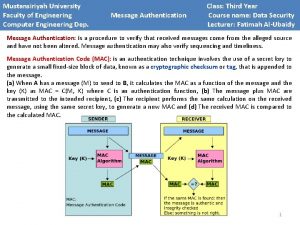Mustansiriyah University Faculty of Engineering Computer Engineering Dep



- Slides: 3

Mustansiriyah University Faculty of Engineering Computer Engineering Dep. User Authentication Class: Third Year Course name: Data Security Lecturer: Fatimah Al-Ubaidy The Kerberos Version 4 Protocol: 1 - The client C requests a ticket-granting ticket TGT by sending its user’s ID to the AS, together with the TGS ID, indicating a request to use the TGS service. This message also includes a timestamp, indicating the date and time at which the ticket was issued, so that the AS knows that the message is timely. 2 - The AS responds with a message, encrypted with a key derived from the user’s password (Kc), that contains the ticket. The encrypted message also contains a copy of the session key, Kc, tgs, where the subscripts indicate that this is a session key for C and TGS. 1

Mustansiriyah University Faculty of Engineering Computer Engineering Dep. User Authentication Class: Third Year Course name: Data Security Lecturer: Fatimah Al-Ubaidy The Kerberos Version 4 Protocol: * The ticket itself consists of the ID and network address of the user, and the ID of the TGS. The idea is that the client can use this ticket to request multiple service-granting tickets. So the ticket-granting ticket is to be reusable. The ticket also includes a timestamp, indicating the date and time at which the ticket was issued, and a lifetime, indicating the length of time for which the ticket is valid. 3 - The C requests a service-granting ticket. For this purpose, C sends the TGS a message that includes the ticket, the ID of the requested service and an authenticator, which includes the ID and address of C’s user and a timestamp. * The authenticator is intended for use only once and has a very short lifetime. The TGS can decrypt the ticket with the key that it shares with the AS. This ticket indicates that user C has been provided with the session key Kc, tgs. * The TGS can then check the name and address from the authenticator with that of the ticket and with the network address of the incoming message. If all match, then the TGS is assured that the sender of the ticket is indeed the ticket’s real owner. Note that the ticket does not prove anyone’s identity but is a way to distribute keys securely. It is the authenticator that proves the client’s identity. 4 - The TGS decrypts the incoming ticket Tickettgs using a key Ktgs shared by the AS and the TGS and verifies the success of the decryption by the presence of its ID. It checks to make sure that the lifetime has not expired. Then it compares the user ID and network address with the incoming information to authenticate the user C. If the user is permitted access to the server V, the TGS issues a ticket Ticketv to grant access to the requested service. Then, the TGS replays with an encrypted message using the session key shared by the TGS and C and includes a session key to be shared between C and the server V, the ID of V, the service-granted ticket Ticketv and the timestamp of the ticket. The ticket itself includes the same session key. 5 - The C requests access to a service. For this purpose, the C transmits a message to the V containing a reusable service -granting ticket Ticketv as well as an authenticator to V. The V authenticates by using the contents of the ticket. 6 - The server returns the value of the timestamp from the authenticator, incremented by 1, and encrypted using the shared session key Kc, v between the client and the server. 2

Mustansiriyah University Faculty of Engineering Computer Engineering Dep. User Authentication Class: Third Year Course name: Data Security Lecturer: Fatimah Al-Ubaidy The Kerberos Version 4 Protocol: * Because the message was encrypted by the session key, C is assured that it could have been created only by V. The contents of the message assure C that this is not a replay of an old reply. * At the conclusion of this process, the client and server share a secret key. This key can be used to encrypt future messages between the two or to exchange a new random session key for that purpose. The Kerberos Exchanges 3





